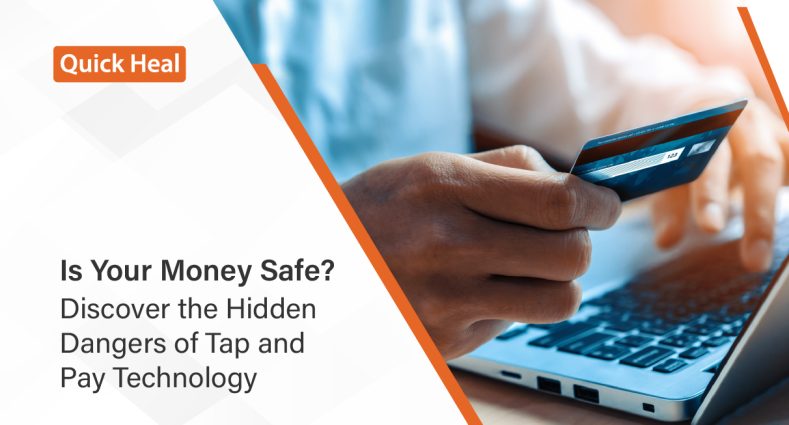Is Your Money Safe? Discover the Hidden Dangers of Tap and Pay Technology

Tap and pay technology has completely changed the way we do transactions. Imagine making a payment just by tapping your card or mobile device on a terminal – it’s that simple and quick! No wonder it’s becoming the go-to choice for people all over the world, offering a hassle-free alternative to carrying cash.
But, let’s not get carried away with its convenience – you should be aware of some important contactless card security issues. As we embrace digital transactions, security and privacy concerns are cropping up. So, let’s dive a bit deeper into how this tap-and-pay technology works.
Understanding Tap and Pay Technology
Tap and pay technology, is taking over the way we handle transactions these days. It’s all about convenience and speed. With just a quick tap of your smartphone, smartwatch, or contactless card, your payment is done in seconds.
Think about it – no more fumbling for cash, no need to enter a PIN or sign anything. Just tap and go! From retail stores to public transport systems, tap-and-pay integration has transformed how people pay for goods and services. Mobile payment apps and security contactless cards have made this technology accessible to a broader audience, further fueling its growth in everyday transactions.
Tap and Pay: Common Devices and Platforms
Smartphones: Brands like Apple and Google have added NFC chips to their phones. Just store your credit card info securely and use apps like Apple Pay or Google Pay to make quick payments with a tap.
Smartwatches: Got an Apple Watch or a Fitbit? These wearables with NFC let you pay right from your wrist. No need to carry cards or your phone – tap your watch and go!
Contactless Cards: Banks are issuing cards with NFC technology, so you can tap to pay at stores, restaurants, and even on public transport. It’s super quick and convenient.
Transportation Systems: In many cities, you can now tap and pay for public transit through your phone or card.
Retail Stores and Businesses: More and more shops are getting NFC-enabled payment terminals. This means you can tap your device or card to pay, speeding up the checkout process.
While tap-and-pay technology offers convenience, ensuring security is paramount. Devices and platforms using NFC technology implement encryption and tokenization to protect users’ payment information during transactions. Users must update their devices with the latest security patches and enable additional authentication methods like biometric scans or PINs for added protection.
Emerging Cyber Threats to Tap and Pay
As tap-and-pay technology continues to evolve, so do the challenges posed by emerging cyber threats. Some of them include:
Relay Attacks in Tap and Pay Systems
Relay attacks are sophisticated cyber attacks that target the communication between NFC-enabled devices, such as smartphones or contactless cards, and payment terminals.
Here’s how relay attacks work:
When a user initiates a transaction by tapping their device on a payment terminal, attackers intercept and relay the communication between the device and the terminal over a longer distance.
This involves two primary attackers: one near the payment terminal (the ‘reader’) and another near the victim’s device (the ‘tag’). The reader captures the transaction details from the victim’s device using NFC, while the tag relays these details to the terminal as if the attacker’s device were the victim’s device.
To mitigate relay attacks, newer NFC technologies include features such as distance bounding protocols and secure elements that limit communication range and ensure that the transaction occurs only when the device is near the terminal.
Malware and Phishing Threats to Tap and Pay
Malware and phishing pose significant threats to tap and pay technology systems:
Malware: Malicious software can infect smartphones or other NFC-enabled devices, compromising contactless card security. Malware targeting tap and pay technology systems can intercept transaction details or manipulate payment processes to divert funds to unauthorized accounts.
Phishing: Phishing attacks trick users into revealing sensitive information, such as login credentials or payment details, through deceptive emails, messages, or websites. Attackers may impersonate legitimate payment apps or services, leading users to unwittingly disclose their financial information.
Quick Heal Total Security offers robust protection against malware and phishing attacks targeting tap and pay systems through several key features. It includes real-time threat protection, which detects and removes malware, including those that specifically target NFC-enabled devices.
Additionally, the Secure Wi-Fi Network feature ensures secure browsing and prevents unauthorized access to sensitive data when using public Wi-Fi networks, thereby reducing the risk of network-based attacks on tap-and-pay transactions. Moreover, Quick Heal’s SafePe feature provides a layer of contactless payment card security for financial transactions, safeguarding sensitive information from malware threats during tap-and-pay transactions.
Network Vulnerabilities in Tap and Pay Transactions
Using public Wi-Fi networks for tap-and-pay transactions exposes users to several risks:
Man-in-the-Middle Attacks: Attackers can intercept communications between the device and payment terminal over public Wi-Fi, potentially capturing sensitive information such as payment details or authentication credentials.
Data Interception: Unsecured public Wi-Fi networks lack encryption, making it easier for attackers to eavesdrop on data transmissions and steal valuable information related to tap and pay transactions.
To mitigate network vulnerabilities, users should avoid conducting tap-and-pay transactions over public Wi-Fi networks whenever possible. Instead, opt for secure and trusted networks or use VPNs (Virtual Private Networks) to encrypt data transmissions and enhance privacy and contactless card security.
Advantages of Tap-and-Pay Technology
Tap-and-pay technology offers several compelling benefits that have contributed to its widespread adoption:
Speed: Transactions are completed in mere seconds, eliminating the need for cash or PIN entry.
Convenience: No more fumbling with change or waiting for chip card transactions to process.
Contactless: Minimizes physical contact with payment terminals, promoting hygiene and safety.
Seamless integration: Compatible with most modern credit cards and smartphones.
These advantages have significantly impacted consumer behavior, with more people embracing tap-and-pay for its ease and efficiency. However, it’s crucial to be aware of the potential security risks to make informed decisions about using this technology.
Best Practices for Safe Use of Tap-and-Pay Technology
To enhance your security while enjoying the benefits of tap-and-pay, follow these actionable tips:
Monitor Account Activity
Regularly review your bank statements and transaction history for any unauthorized charges. Tap and pay fraud can occur if your card or device is stolen or compromised. By keeping a close eye on your account activity, you can quickly identify and report suspicious transactions to your bank, minimizing the potential for financial loss.
Use Strong Authentication
Whenever possible, enable strong authentication measures such as biometric security (fingerprint or facial recognition) and secure PINs on your devices. This adds an extra layer of protection, making it harder for fraudsters to access your accounts even if your card or device is lost or stolen. Contactless card fraud often involves the theft of physical cards, so using strong authentication can help mitigate this risk.
Be Aware of Your Surroundings
When using tap-and-pay in public spaces, be cautious of your surroundings to avoid falling victim to contactless card scams. Fraudsters may attempt to skim your card information using hidden readers or by observing your transactions. Always keep your card or device close to your body and shield the payment terminal with your hand when tapping. If something seems suspicious, trust your instincts and use an alternative payment method.
Secure Your Tap and Pay Experience with Quick Heal
While tap-and-pay technology offers unparalleled convenience in modern transactions, it also presents significant contactless card security issues that users must be aware of. From the threat of relay attacks and malware to vulnerabilities on public Wi-Fi networks, understanding these risks is crucial to safeguarding your financial information and personal data.
Quick Heal Total Security provides essential tools to mitigate these risks effectively. With features like real-time threat protection, secure Wi-Fi network safeguards, and SafePe for secure financial transactions, Quick Heal ensures that users can carry out tap-and-pay transactions with confidence.
At just Rs. 1591 for a year, ensure the online safety of your family with Quick Heal Total Security!
Shop Safely with Quick Heal
Tap-and-pay technology offers unmatched convenience and speed, but it’s essential to be aware of the potential security risks. For comprehensive protection against cyber threats, consider using a robust security solution like Quick Heal Total Security. With advanced features like real-time malware detection, safe banking, and anti-phishing protection, Quick Heal Total Security provides an extra layer of defense for your digital life.



No Comments, Be The First!